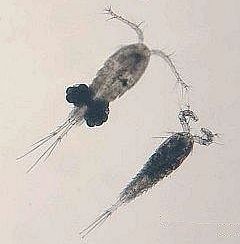
It is that one eye that defines the cyclops. And so a tiny fresh water copepod possessing one eye (sometimes red, sometimes black) is named cyclops as well.
Thanks to its small size (0.5 to 2 millimeters) and its jerky movements, it (also the daphnia) has been nicknamed “water flea.” It is instructive to watch this brief video of a male.
Description
Cyclops feeds on plankton. It thrives in stagnant ponds. It does not require sexual fertilization to reproduce. But it does engage in sexual reproduction during periods of drought to provide eggs that endure dry conditions. When an egg hatches, it produces a nauplius, as seen in this video.
Unfortunately, the one eyed copepod has been associated with ill health. On the plus side, it is considered an excellent, high protein food for aquarium fish. The one eyed creatures are eaten by hydras and by certain mosquito larvae.
Cyclops and Illness – Guinea Worm
The creature may contain the larvae of the Guinea worm, a parasite found just north of the equator in Africa. The condition associated with Guinea worm is seldom fatal, but it is severely debilitating.
Called dracunculiasis, symptoms include tissue swelling, itching, burning, blistering, nausea, vomiting, and diarrhea. Abscesses, arthritis, and even crippling can result. As of yet there is no cure! Worms must be very slowly extracted. See the World Health Organization PDF file, referenced below.
Cyclops and Global Warming
Some researchers such as those found at the James Madison University, believe this copepod is a sensitive and excellent indicator of global warming. These living indicators may help quantify its degree.
Transplanting
The wide spread of this creature should serve as no surprise. Wading birds often transplant the little crustaceans from one body of water to another. Thus ducks, herons, and other water birds serve as unwitting taxis.
1 A nymph is a minor female nature deity.
Note: You might also enjoy The Differences Between Flagella and Cilia
References:
- WHO: Water Sanitation Health: Cyclops
- Microbus: Cyclops, Crustacean, Copepod
- Fairfax County Public Schools: Copepod
← Back to Classic Science
← Home
